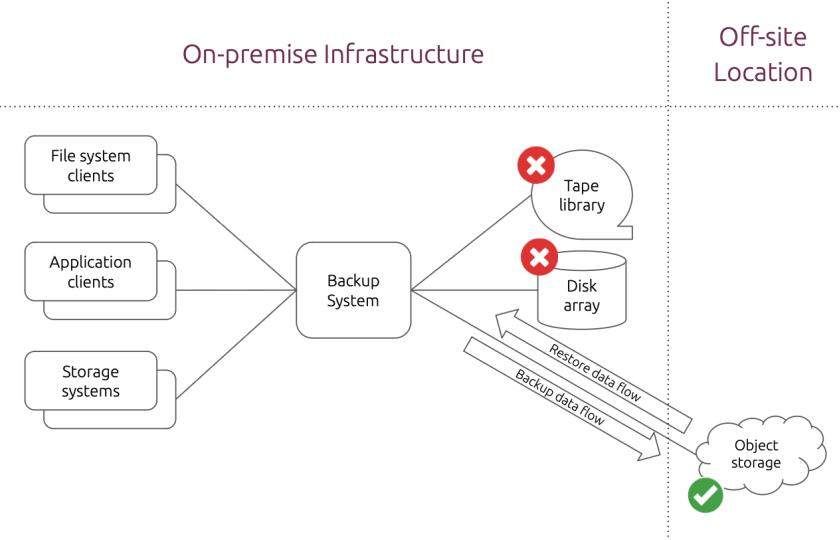Philip Williams
on 21 November 2023
Say goodbye to tape, and hello to flexible cloud backup.

Today the lowest cost media per terabyte for backups is still tape, even after factoring in the handling costs of manually loading and unloading tape libraries, and logistics surrounding off-site storage. However, while inexpensive, tapes are inflexible. And when used as an offline solution it can take many hours to retrieve them from offsite storage – not to mention the additional time required to load them into a tape library before a recovery can even start.
Cloud backup is emerging as an increasingly viable alternative to traditional tapes. Over the last few years there have been significant decreases in the cost of internet connectivity, making remote-online storage a competitive option. Cloud backup is more convenient than tape, more durable, and it can even be less expensive depending on your use cases.
Most modern backup solutions such as Commvault, Trillio, and Veeam now support using object storage in a public cloud, but for significant volumes of data, the costs can soon spiral out of control. Open source solutions like Ceph can be deployed and operated as a stand-alone storage system, at lower cost, yet still have similar flexibility to public cloud storage.
Ceph is an open source software-defined storage solution designed to address block, file and object storage needs. Its highly scalable architecture sees it being adopted as the new norm for high-growth public cloud alike use cases.
Let’s look at the key reasons you might want to consider cloud backup over tapes.
Cloud backup can be more cost-effective
You can unlock considerable, immediate cost savings by using remote cloud storage for backups, as there is no need to purchase tape libraries or disk arrays, or deploy and maintain them in house. What’s more, with cloud backup you don’t have to manage tape rotations and off-siting processes.
Initial capital savings make public cloud storage attractive, however private cloud infrastructure is often more cost-effective in the long term. Over time, public cloud costs typically far exceed the initial investment required to deploy your own cloud storage solution, especially for a predictable workload like backups.
Cloud backup stores data off-site immediately
The greatest benefit to using cloud storage for your backups is that you no longer have a period of time where your backups are not yet off-site. When using cloud storage, once the backup job is complete the data is already stored in another location, and no manual handling of media is required.
To further reduce the risk of data-loss, you can set up replication to another cloud storage system, ensuring data is preserved in the unlikely event of multiple site or system failures.
Corruption is less likely with cloud backup
The likelihood of data loss on tape is very low, but with an online system we have the opportunity to constantly scrub the data. The ability to read blocks of data and compare with checksums that are stored as metadata enables early identification of extremely rare (but possible) on-disk corruption. Furthermore, this corruption can be repaired from other replicas or by rebuilding an erasure coded stripe of data.
Restoring data from a cloud backup is faster
Using an online type of storage system for your backups means that restores can be started instantly, rather than having to wait for tapes that have been off-sited to be transported and loaded into your tape library.
How does cloud backup work?

Tape libraries and disk arrays are typically hosted onsite, which means that they do not provide disaster safety until tapes are ejected and transported to a storage facility. A Disk based system in the same data centre would provide a rapid means of recovery from malicious or accidental deletion of data, but is unlikely to help in a true site-wide disaster scenario.
To utilise offsite-online storage for backups, local storage components are retired from the backup infrastructure. Backup software is reconfigured to utilise either public cloud storage like AWS S3 or Azure blob. Or for improved economics, open source Ceph can be deployed in another data centre and used as the backup target.
Learn more
In this whitepaper, we discuss using Ceph in a co-located data centre to provide storage for workloads in a public cloud, and the same methods used can be applied to provide cost-effective online backup storage. The whitepaper offers a detailed introduction to Ceph, and explores the different types of storage systems, the different access methods used to store and retrieve data, and how data can be protected.



